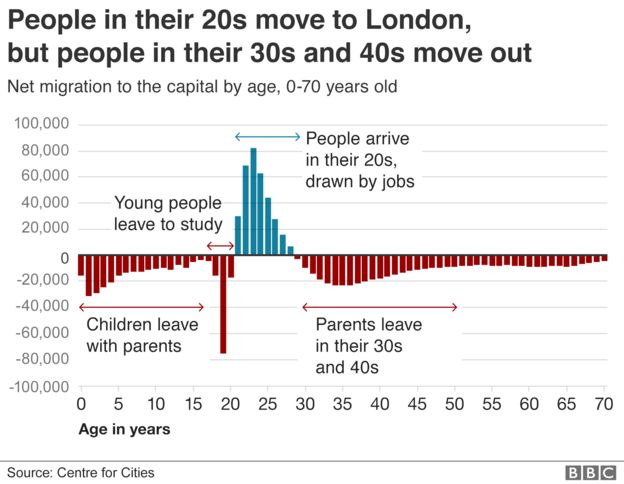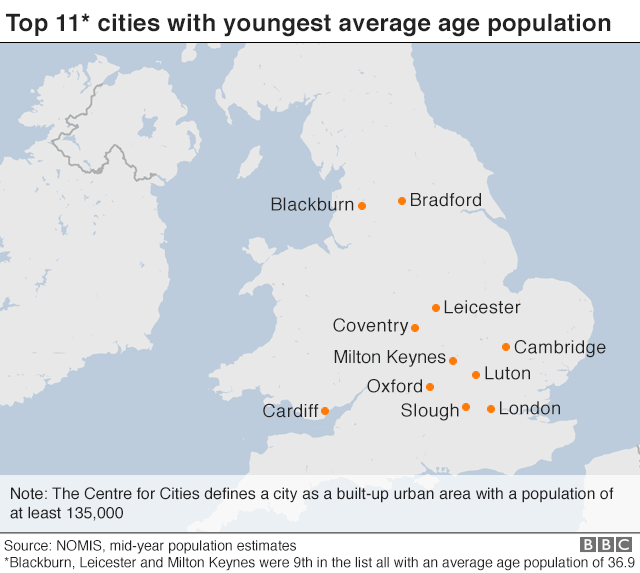 GETTY IMAGES It’s no secret that London has a very successful economy, not just compared with the rest of the UK but with other international cities too. (So với các thành phố khác trong nước và trên thế giới, rõ ràng London có một nền kinh tế phát triển thành công.)
GETTY IMAGES It’s no secret that London has a very successful economy, not just compared with the rest of the UK but with other international cities too. (So với các thành phố khác trong nước và trên thế giới, rõ ràng London có một nền kinh tế phát triển thành công.)Over the past decade its economy has expanded by a fifth. Ever more shops, restaurants and bars have opened to serve its residents.
As a result the population of London and the urban area surrounding it has grown significantly, increasing by 1.1 million between 2008 and 2017 to 10 million people.
Trong hơn một thập kỷ qua, nền kinh tế London đã mở rộng thêm một phần năm. Nhiều cửa hàng, nhà hàng và quán bar đã được mở ra để phục vụ cư dân thành phố.
Kết quả là dân số London và khu vực thành thị xung quanh London đã tăng đáng kể – dân tăng thêm 1,1 triệu người trong khoảng thời gian từ 2008 -2017, đạt tới 10 triệu cư dân.
Yet despite this success story, not everything is going its way.
Many more people pack their bags and leave the capital for elsewhere in England and Wales than make the journey the other way.
Thành công là vậy, nhưng mọi thứ không phải khi nào cũng diễn ra theo cách mà chúng ta nghĩ.
Thay vì ở lại thủ đô London, nhiều người đã rời đến sống ở các vùng khác ở Anh và xứ Wales.
Over the past decade, about 550,000 more Britons left London than moved to it.
This trend is not unique to London; it is seen in many big US cities, including New York, Miami, Chicago and Los Angeles.
So why has the capital’s population continued to grow despite so many people leaving? It can be explained by two factors.
Đây không phải là một xu hướng mới vì trước đó nó cũng đã xảy ra ở các thành phố lớn của Mỹ như New York, Miami, Chicago và Los Angeles.
Vậy tại sao dân số London vẫn tăng lên dù cho nhiều người rời đi? Điều này có thể được giải thích bởi hai yếu tố.
The first was its birth rate: 790,000 more people were born in London than died between 2009 and 2017.
The second factor was international immigration. There was an increase of 860,000 between 2009 and 2017, with more than half coming from the EU. By 2017, 3.6 million people living in the city were born overseas.
Đầu tiên là tỷ lệ sinh: 790,000 trẻ em đã được sinh ra ở London từ năm 2009 đến 2017.
Yếu tố thứ hai là nhập cư quốc tế. Thêm 860,000 người đã nhập cư vào London từ năm 2009 đến 2017, với hơn một nửa số đó đến từ châu Âu. Tính đến năm 2017, có 3,6 triệu người sống ở London được sinh ra ở nước ngoài.
Of the Britons moving to the capital, a look at their ages reveals a great deal.
Trong số những người Anh chuyển đến thủ đô London, độ tuổi của họ tiết lộ thêm nhiều thông tin thú vị.

A large number of people move to London in their 20s, drawn from all corners of the country.
This is because of the range and number of job opportunities that the capital offers.
But among almost every other age group, the capital sees more people leaving than arriving.
This is most pronounced for very young children, people aged 18-20 and people in their 30s.
Theo đó, nhiều người ngoài 20 tuổi từ các vùng khác nhau ở Anh đã chuyển đến sống ở London để tìm việc làm.
Tuy nhiên, người ở độ tuổi từ 18 đến 20 hay ngoài 30 lại định rời khỏi London.
A look at where people move to after leaving the capital offers an insight into why this happens.
Điểm đến của người dân sau khi rời London cũng giải thích tại sao xảy ra xu hướng này.
 GETTY IMAGES
GETTY IMAGES
The 18-20 age group spreads out across the country, especially going to cities such as Nottingham, Coventry and Brighton. The most common reason is to start university.
It is safe to assume the other age groups – the children up to four years old and the 30-somethings – are leaving together. Paddington train station isn’t full of unaccompanied toddlers with their suitcases.
These are the young families moving out of the capital, very often in search of homes for less than London’s notoriously high prices.
Thanh niên từ 18 đến 20 tuổi thường chuyển đến sống ở khắp mọi nơi trong nước, nhất là tại các thành phố Nottingham, Coventry và Brighton. Lý do chung chính là đi học đại học.
Trong khi đó, trẻ em dưới bốn tuổi và những người ngoài 30 tuổi thường rời đi cùng nhau.
Đây là những gia đình trẻ đang rời thủ đô London để tìm mua nhà ở các vùng khác rẻ hơn.
Yet this does not mean that they are giving up on London altogether and returning “home” to the other parts of the country they first moved from.
Tuy nhiên, điều này không có nghĩa là họ đã rời khỏi London hoàn toàn. Thay vào đó, nhiều người vẫn đi đi về về giữa nhà mới và London để làm việc.
Hai phần ba nhóm này thường chuyển đến sống ở vùng Đông Nam của nước Anh, trải dài từ Southampton đến Milton Keynes và Norfolk.
Unlike people moving for university, many stay within commuting distance.
Dù không sống ở London nữa, họ vẫn có thể đến đây làm việc.
 GETTY IMAGES Two-thirds of these age groups remain in what might be called “the Greater South East” – an area stretching from Southampton up to Milton Keynes and across to Norfolk.
GETTY IMAGES Two-thirds of these age groups remain in what might be called “the Greater South East” – an area stretching from Southampton up to Milton Keynes and across to Norfolk.So while they no longer live in the city, they still have the option to work there.
And the 800,000 people who commute into London each day – more than the entire population of cities such as Leeds and Bristol – suggest that many of them do.
Among those Londoners who remain past their 30s more continue to leave than arrive, albeit in smaller numbers.
Có khoảng 800,000 người đến London làm việc mỗi ngày – nhiều hơn toàn bộ dân số các thành phố như Leeds và Bristol.
Một số nhỏ những người trên 30 tuổi còn lại ở London cũng đang có xu hướng rời đi.
These flows of people – the arrival of large numbers of young people and the departure of many of those who are older – also explains why London is such a young city.
With an average age of 37, its population is the sixth youngest of any large town or city in the UK. Oxford, Cambridge and Coventry all have populations with an average age under 36, while in Swansea and Sunderland, the oldest, it is 41.
Xu hướng di dân này khiến London luôn là một thành phố trẻ.
Với độ tuổi trung bình là 37, London có dân số trẻ đứng thứ sáu cả nước.
Trong khi đó, độ tuổi trung bình ở Oxford, Cambridge và Coventry là 36, và ở Swansea và Sunderland là 41, già nhất cả nước.

London’s experience differs to other big British cities.
Places like Liverpool, Sheffield, Newcastle and Nottingham have also seen their population and economies grow. But the waves of people arriving and leaving are very different.
Các thành phố như Liverpool, Sheffield, Newcastle và Nottingham cũng có nền kinh tế và dân số phát triển. Tuy nhiên, làn sóng di dân ở đây lại khác so với London.
They see two waves of people leaving – one for those aged 21-30 (many of whom head to London) and a second for people aged over 30.
The inflow and first wave of out-migration is related to universities.
Hiện có hai làn sóng di dân ở các thành phố này, đối với những người ở độ tuổi từ 21 đến 30 (thường chuyển đến London) và những người ngoài 30 tuổi.
Đầu tiên, xu hướng di dân này liên quan đến việc học đại học.
These cities have a number of universities in them and attract many thousands of students from across the country, including London. But many of these students leave the cities behind as easily as they moved to them once they graduate.
Taking Liverpool as an example, it sees an inflow of people aged 18-20 from almost every other city in England and Wales. But the opposite trend is seen for 21 to 30-year-olds, with the city losing more of this age group to almost every other city than it gains.
Nhờ vào số lượng các trường đại học, các thành phố này thu hút hàng ngàn sinh viên từ khắp cả nước, bao gồm London.
Tuy nhiên nhiều sinh viên thường rời các thành phố này sau khi tốt nghiệp, dễ dàng như lúc họ đến vậy.
Chẳng hạn như ở Liverpool, nhiều thanh niên ở độ tuổi từ 18 đến 20 đã chuyển đến đây từ khắp nơi trên nước Anh và xứ Wales. Trong khi đó, những người từ 21 đến 30 tuổi lại có xu hướng rời đi.

However, it is crucial to note that some of these students do stay on.
In the case of Liverpool, one in five of the students who move to the city for university make it their home after graduation. And so the number of highly qualified young people living in the city increases overall.
Tuy nhiên, một số sinh viên vẫn chọn ở lại Liverpool sau khi ra trường.
Cụ thể, cứ năm sinh viên đến đây học thì có một sinh viên chọn ở lại sau tốt nghiệp. Theo đó, số lượng những người trẻ có trình độ cao trong thành phố tăng lên.
But like London, these big cities also experience a second wave of people leaving when they hit their 30s.
And like the capital, these people don’t move very far, once again looking for somewhere for their families to live.
For example, people leaving Birmingham tend to head for places like Shropshire or Staffordshire. And people leaving Newcastle mainly move to neighbouring Northumberland and County Durham.
Trong khi đó, tương tự như London, những người ngoài 30 tuổi ở các thành phố này lại cùng gia đình chuyển đến sống ở các vùng khác.
Ví dụ, những người sống ở Birmingham có xu hướng chuyển đến những nơi như Shropshire hay Staffordshire. Và những người rời Newcastle thì chủ yếu chuyển đến các vùng lân cận như Northumberland và hạt Durham.
These patterns show that different places offer different things to people as they get older.
The vibrancy and job opportunities offered by our biggest cities appeal to students and young professionals. This shapes these cities in terms of the shops, bars and other facilities they offer.
Xu hướng di dân này cho thấy, ở các độ tuổi khác nhau, con người thường tìm kiếm những thứ khác nhau ở những nơi khác nhau.
Theo đó, sự năng động và cơ hội việc làm ở các thành phố lớn thu hút sinh viên và nhân viên trẻ tuổi. Điều này có tác động đến số lượng các cửa hàng, quán bar và các dịch vụ khác trong thành phố.
But among older residents, the desire for things like more space and a less urban environment grows, and many move out.
It reminds us that cities are not islands, with residents flowing in and out of them depending on their stage of life.
With it comes the challenge of making sure there is the right type of housing where people want to live and the transport to get them about.
Đối với những người lớn tuổi hơn, nhu cầu về không gian và môi trường yên bình hơn khiến họ rời các thành phố lớn.
Điều này nhắc nhở chúng ta rằng, các thành phố không phải là các hòn đảo, vì người dân đến và đi tùy theo độ tuổi.
Thách thức đi kèm với xu hướng này là vấn đề nhà ở và phương tiện đi lại để đáp ứng nhu cầu của người dân.
About this piece
This analysis piece was commissioned by the BBC from experts working for an outside organisation.
Andrew Carter is chief executive and Paul Swinney is director at the Centre for Cities, which describes itself as working to understand how and why economic growth and change takes place in the UK’s cities.
This piece uses data from the ONS on England and Wales’s 58 largest urban areas. Comparable data is not available for Scotland and Northern Ireland.
Nguồn: BBC
Bản dịch (có thể bị sửa vì sai ý người viết)
